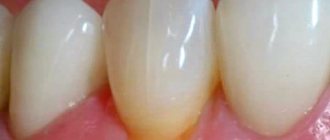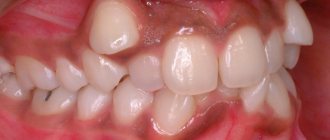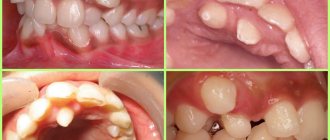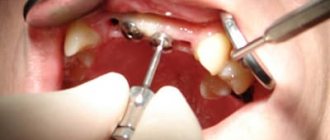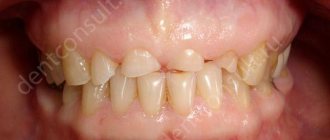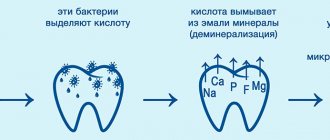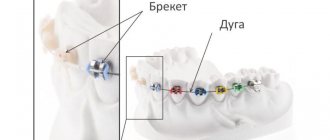When communicating with some people, it is impossible not to pay attention to the strange, unnatural and sometimes even frightening color of teeth. Sometimes a yellowish or grayish tint appears on them. It happens that brown spots appear directly on the teeth. All this, as a rule, indicates so-called pigmentation. How does it manifest itself, where does it come from and how to deal with it? These are, perhaps, the main questions that concern people who have encountered similar phenomena. In order to understand how to deal with such a problem, we must penetrate into its essence, find out for ourselves what are the known causes of tooth pigmentation.
External pigmentation on teeth
Among dentists, causes are usually divided into external and internal. Let's start, perhaps, with external factors. These usually include those substances that we use in everyday life, which externally stain the tooth, penetrating into the pores of its enamel.
The most dangerous factor can be called smoking, because the nicotine resins contained in tobacco give the enamel an unpleasant yellowish-brown tint. A similar substance in its effects is coffee. It is also impossible not to mention strong black tea and red wine. They also play an important role in destroying tooth enamel and giving it an unaesthetic appearance.
We must not forget about the huge number of food dyes, in which the coloring pigments cause damage. And, of course, one cannot fail to mention the stones and plaque that arise due to violation of oral hygiene rules, lack of minerals in the body and a minimal amount of solid food or even its absence in the diet. External manifestations of pigmentation on teeth are not difficult to eliminate. All you need is advice from a dentist. You will also need to use the right toothpaste.
Internal pigmentation
The situation is much more complicated with internal pigmentation, because then the internal hard tissue of the tooth is already stained. There can be a huge number of reasons for such changes in the oral cavity. One of the most common is a change in the balance of fluoride in the body. Why? Fluoride has a destructive effect on teeth, since the tissue changes its color depending on its lack or excess.
Stories are replete with cases where all the villagers had the same stains on their teeth because all the villagers drank water from the same underground springs. In some cases, staining of tooth enamel occurs due to the use of tetracycline antibiotics. It also happens that the cause of such a problem can be a filling placed as a result of dental surgery, provided that the material was made of copper amalgam.
For some, pigmentation comes with age. Hereditary factors also play a role. In children, pigmentation on the teeth can also be due to an improper diet and a sharp change in temperature in the oral cavity, for example, when consuming cold food immediately after hot food.
At home
The use of folk remedies is not recommended for children when baby teeth are replaced by molars. Some substances are potent and can damage tooth enamel.
It is recommended that pregnant women use some products with caution. During this period, the body is under double load. In most cases, dark spots on teeth in pregnant women go away on their own after childbirth.
Hormonal levels and metabolic processes quickly return to normal.
Diagnostics: what methods are used in dentistry?
Science, unfortunately, has not yet made big strides in diagnosing dental pigmentation. Limitations in laboratory and clinical research, the lack of availability of high-quality and modern equipment affect the efficiency of dentists.
But, despite all the obstacles, in our country there are a huge number of specialists endowed with intelligence and experience who, after conducting only a visual examination of the patient, will be able to accurately diagnose pigmentation on the teeth. Although there are often cases when in diagnosis it is necessary to resort to modern technologies, such as radiography or orthopantomography, with the help of which the dentist studies the internal problems of damaged teeth.
Doctors have a large number of other devices and methods in their arsenal that are used in particularly difficult situations. These include, for example, microscopy or rheodentography. They allow the specialist to examine the problem in more detail. And in the study of tissues such as gums or blood vessels, a device called a reparodontograph is often used.
Treatment
How to get rid of stains on teeth? Pigmentation is removed based on the causes that caused it. It is usually carried out in stages:
- First, the specialist cleans the tooth surface from existing plaque using a special excavator and a brush with a special abrasive paste;
- After cleaning, the doctor disinfects the gum tissue and dental units with a special composition;
- If pigmentation is caused by a change in salivary composition, the patient is prescribed vitamins and drug treatment (Profokar, Bonding, Monobond Plus);
- To consolidate the results, the enamel is covered with a layer of medicinal varnish. This helps protect it from pathogenic microorganisms, provides impermeability and increases the strength of the enamel layer. Particularly effective for hypersensitivity.
We suggest you read: How to get rid of caries yourself
Removing stains on teeth requires a revision of lifestyle and attitude towards health:
- Plaque and tartar are removed in the dentist's office with professional cleaning.
- Bad habits require giving up or reducing the consumption of coloring drinks and smoking;
- Medicines that cause darkening of the enamel should be eliminated or minimized.
- Poor quality filling requires re-doing (according to all the rules); the presence of concomitant diseases requires their treatment.
- Abnormal levels of fluoride in the body require its correction (by reducing or increasing its consumption through water, food, pasta).
- Dental problems require appropriate treatment.
The main methods of eliminating tooth pigmentation are whitening, lamination of vestibular surfaces with adhesive or ceramic veneers, restoration of natural color by making metal-ceramic or metal-free structures. Before starting treatment for tooth pigmentation, the oral cavity is sanitized. Dental plaque is removed using a pneumatic scaler and an air-abrasive system, the principle of which is based on cleaning the enamel with a mixture of water and sodium bicarbonate under the influence of air compressed under high pressure.
The method of internal (intra-canal) and external whitening is used for deep pigmentation of teeth. Hydrogen peroxide is used for this purpose. Activation of oxidation reactions occurs under the influence of light or laser. Several visits may be needed to eliminate tooth pigmentation. One visit is sufficient only in the case of traumatic periodontitis, when tooth staining occurs due to the penetration of putrefactive products of pulp decay deep into the dentinal tubules.
If enamel resistance is low, bleaching is contraindicated. In this case, orthopedic methods are used to restore the aesthetic component - microprosthetics or the production of full ceramic crowns. The prognosis depends on the etiology of tooth pigmentation. Tetracycline teeth and discolorations caused by oxidation of metal intracanal pins and silver amalgams are practically impossible to whiten.
Is it necessary to treat such an illness?
How many people plan to treat tooth pigmentation? Most people consider the problem to be purely cosmetic. There are many reasons for such negligence on the part of patients. This includes illiteracy, arrogance, carelessness, and often, of course, fear. It always seems to the average person that now he will introduce more vegetables and dairy products into his diet, start using more expensive toothpaste, and the problem will be eliminated. But it won't work that way.
The color of the teeth will not acquire the desired snow-white shade. If such a problem arises, you should immediately contact a specialist, and the sooner you do this, the better for you. Moreover, both from the aesthetic and material side. Using special equipment, a dentist can easily rid you of external plaque on tooth enamel, identify the internal cause of pigmentation and, accordingly, prescribe a specific course of treatment in order to eliminate not only the symptoms of the disease, but also the disease itself.
How not to get confused?
Diseases that cause changes in pigmentation, with similar symptoms, lead to different consequences, and therefore it is important to be able to distinguish between them. Of course, only a specialist can make an accurate diagnosis. And yet, according to some signs, one can judge the presence of a particular disease.
- 1. A mild degree of fluorosis (excess fluoride) is similar to initial caries - only the localization of white spots on a child’s teeth is different. With fluorosis, light spots are located closer to the edge of the incisor, and not in the cervical area.
- 2. Fluorosis spreads to all teeth or most of them (mottling of enamel), in contrast to caries, which affects individual or adjacent teeth. (Multiple caries is classified as a carious disease).
- 3. With fluorosis, the enamel pattern is symmetrical on the teeth of the same name and on the opposite ones. The spots are stable and do not change their appearance.
- 4. Hypoplasia, like fluorosis, manifests itself immediately, at the time of teething, in contrast to caries.
We suggest you read How to get rid of purulent plugs in the tonsils?
Colgate Simply White Night Gel
The list of common treatments is relatively small and is available to everyone. Most drugs are undesirable to use without the advice of a specialist. However, what to do when there is not always enough free time to visit the dentist, and the problem requires an immediate solution due to certain life circumstances? In such cases, you can rely on some cosmetic products, such as some toothpastes or gels.
There are an endless number of different options, but the most popular among ordinary consumers is Colgate Simply White Night gel. A group of scientists was given a task: how to whiten teeth without harming the enamel, and to do it in such a way that everyone could do it at home.
The method of application is extremely simple, as it was created from the point of view of maximum comfort.
How to use the gel?
To begin, you simply need to clean your tooth enamel using standard methods, such as a toothbrush and toothpaste. This is necessary so that there are no excess bacteria in the oral cavity and the space is ready for treatment. Then you should dry each tooth with a special swab and apply the gel to them.
It is recommended not to eat anything for 15-20 minutes. And thus, within a few days you will notice the result, and after a longer time, your smile will finally acquire that desired shine. The effect of such whitening can be observed for about one year. Then the course must be repeated.
The drug "Gluflutored"
However, not all products are as simple, effective and easy to use as the gel described above. Most drugs can be harmful if used without proper prescription from a doctor, who will instruct in detail and warn against potential risks.
The specialist will tell you how to get rid of external and internal manifestations of pigmentation, how to strengthen tooth enamel and prevent diseases. An effective way to get rid of the problem is to change the chemical composition of saliva by influencing the thyroid gland with a certain set of minerals, vitamins and fluoride for teeth. One of the most common substances used for treatment in clinical settings is Glufluored.
Restoration and whitening of enamel
Timely restoration of the balance of microelements can prevent the appearance of new defects, but you can get rid of existing white spots with the help of artistic restoration and bleaching.
To do this, the patient may be offered to wear veneers and metal-ceramic structures, a professional whitening procedure (for example, with inorganic acids), and removal of the top layer of enamel with diamond drills followed by polishing.
We invite you to familiarize yourself with Antiseptic agents for treating and rinsing the mouth and teeth
White spots are easy to notice if they appear on the front teeth, but the existence of pigmented areas on molars and premolars may not be known, which is why it is important to have a routine dental check-up at least once a year.
Why do stains appear on teeth?
"Glufluored": how is it used?
It is applied quite simply. The tooth is washed with water and dried. The substance is applied to the enamel surface and disinfected after a minute. The procedure is usually repeated about twice a year. And although glufluored is inherently harmless, it still cannot be used without careful medical supervision. Because the drug requires an extremely precise order of use, as well as applying a precisely measured amount of the composition. After this procedure, the dentist usually applies bonding to the surface of the teeth.
This drug has an official name, which sounds like Monobond Plus. It helps in restoring and strengthening the connections between the surface of the tooth and the substance applied to it. This remedy is, in principle, harmless for most people. The only exceptions may be individual allergic reactions to certain substances contained in boding. But such incidents are rare.
The drug "Remodent"
A wonderful drug with which you can both strengthen your teeth enamel and preserve it for many years is Remodent. 70% of dentists prescribe it for preventive and therapeutic purposes. It has no side effects, with the possible exception of individual allergic reactions. It is effective and easy to use.
You will need 3 g of powder per 100 ml of boiled water at room temperature. You need to rinse your mouth after eating every few days for 10 months.
The main factors for darkening of teeth
There are enough factors that cause a person’s teeth to change their color. If he determines the one that suits his case, he can quite easily prevent further negative consequences. The list of main reasons for darkening of teeth includes:
- Failure to comply with basic hygiene rules: one of the most common reasons. Due to such inactivity, plaque accumulates on the teeth, which consists of microorganisms and remnants of the food that a person eats throughout the day. If this approach to personal dental hygiene is repeated day after day for a long period of time, then over time this can lead to compaction and darkening of all residues. The compacted shell covers and distorts the natural color of the tooth. Outwardly, they will appear darker and duller.
- The second most common reason is tobacco smoke: due to its properties and the content of tarry substances in it, the composition of the smoke gradually covers the teeth in layers and they become yellow. This type of plaque is best removed by non-contact cleaning at the dentist and has no side effects such as pain or harm. Dentists recommend that smokers have it done at least once every six months.
- Also, consuming coffee, black tea, berries, juices, and foods that contain dyes of natural or synthetic origin can lead to a change in the color of tooth enamel. Don't rush to give up all this. All you need to do is simply brush your teeth regularly after meals and use a whitening toothpaste to ensure a snow-white smile. Otherwise, this will lead to the fact that sooner or later the condition and color of the tooth enamel will no longer allow them to return to their former whiteness by independent actions and you will have to seek help from specialists and carry out a professional teeth whitening procedure.
- Tooth decay is the fourth most common cause of tooth discoloration. It itself is formed as a result of the interaction of two factors. Firstly, it is insufficiently good dental care or its complete absence. Secondly, this is the abuse of sweets. Together, these phenomena lead to the development of caries, which ultimately causes stains to appear on the teeth, which become pigmented and darken over time (tooth treatment in the event of caries is recommended to be carried out immediately after pain and stains appear).
- The tooth changes color due to the substances used for filling. More modern means do not have such a side effect, but those that were used literally ten years ago are still capable of producing a similar side effect. Darkening in many dental patients is the result of “metal fillings” made from amalgam. Modern fillings do not have such disadvantages, so if they are present, it is advisable to contact a specialist and have them replaced.
- Tooth trauma can lead to darkening: this occurs due to damage to blood vessels and nerves.
- Changing the color of a tooth is provoked by taking certain types of antibiotics (for adults they are not dangerous in principle, since they accumulate only in the buds of teeth that form in the fetus), therefore an antibiotic such as tetracycline is prohibited from being taken by pregnant women.
- A disease called fluorosis: occurs in people who live in areas where the drinking water contains too much fluoride.
- Heredity: diseases that were passed on to you from your parents can also affect the general condition of your teeth, despite all your efforts in hygiene.
- Aging: with age, teeth darken and their shape undergoes changes (only correction from a specialist will help here). Over time, teeth are subject to natural wear, but modern dentistry can offer many ways to restore the former beauty of a smile thanks to the service of “dental restoration” and prosthetics.
Folk remedies: what methods used by our grandmothers are effective?
It would be blasphemous not to remember folk remedies, proven by the experience of many generations. However, they should also be used in moderation, because they are extremely effective and can not only remove excess plaque, but also erase the enamel. For example, many people sometimes brush their teeth by dipping a brush in baking soda. Rubbing your teeth with hydrogen peroxide is also an equally effective remedy.
We will not deviate from ordinary products, the benefits of which were known long before us. For example, rubbing strawberries on your teeth and gums. Or you can brush your teeth with charcoal from a burnt eggplant.
Remedies for getting rid of stains on enamel at home
Home remedies for teeth stains will not be as effective as methods used at the dentist's office. Doctors do not always advise sticking to traditional recipes, mainly because people at home may not know what to do. For example, the doctor will tell you not to overuse soda recipes, but the person will still use soda rubs every day.
But if you follow the principles of moderation and complexity, some so-called folk recipes can help get rid of stains. You cannot be sure that they will solve the problem completely, but it is possible to reduce its manifestations.
How to deal with stains on your teeth yourself:
- After brushing your teeth, you can wipe them with a slice of lemon or half a strawberry; Wipe your teeth with lemon
- You can also wipe your teeth with the back of a citrus peel, such as a lemon, orange or grapefruit; Use the peel
- activated carbon in the form of tablets crushed and mixed with water also helps to lighten teeth (no more than 2-3 times a week you can apply this slurry to your teeth); Activated carbon
- baking soda is mixed with charcoal, and this composition is applied to the teeth (course no more than 2 weeks). The product is used to clean teeth
Finally, it’s worth remembering an old but proven remedy – regular tooth powder. It perfectly removes color deposits. It is recommended to purchase tooth powder at a pharmacy.
Dentifrice
Dental Whitening Powder

